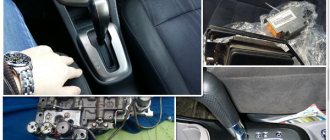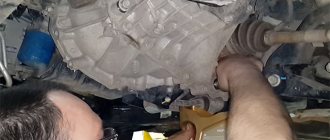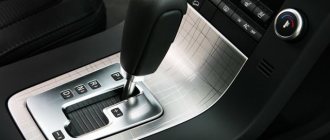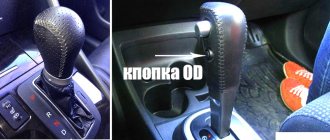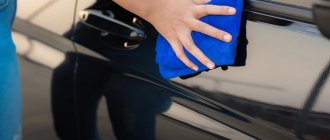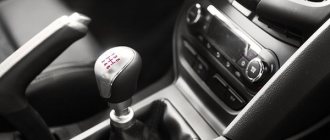Purchasing a tow rope, features of choice
There is little hope for the good old “maybe it will blow through” and a rope of unknown origin, once thrown into the trunk, when it comes to practice.
The absence of a cable or its home-made equivalent can cause a lot of trouble, for example, you will have to call a tow truck or stand idle in a puddle until a motorist is found who has a towing strap and is willing to help. But all problems can be solved with one trip to the store and the purchase of a tow rope.
What to look for when choosing?
Material of manufacture
The cable can be metal, nylon or synthetic.
Steel rope
It is a bundle twisted into several steel threads. The technical characteristics of the product depend on the number of twisted wires and the twisting method.
Advantages of metal rope:
- strength (withstands heavy loads);
- reliability;
- resistance to abrasion.
Minuses:
- heavy weight;
- susceptible to corrosion;
- takes up a lot of space;
- if it bursts, it may cause harm to a person and/or vehicle;
- not elastic.
Synthetic towing belts
Made from:
- nylon;
- Kevlar;
- polyvinyl chloride.
According to the manufacturing method, they can be braided (flat belt) or twisted (rope).
They are inferior to metal cable in strength, with the exception of products made of Kevlar. The latter even surpasses the steel product in terms of endurance, but also costs accordingly. Pros of synthetics:
- light weight;
- compactness;
- long service life;
- elasticity and ability to absorb shock;
- low cost (except for Kevlar).
Minuses:
- are not able to withstand too heavy loads (again, with the exception of Kevlar cable);
- prone to chafing.
What to choose?
For a passenger car, a synthetic version is quite sufficient. Any towing belt made of relatively high quality can withstand such a load. For heavy trucks, you will have to acquire a steel cable, the thickness of which is selected depending on the tonnage of the vehicle.
Length
In accordance with the requirements specified in the traffic regulations, the length of the towing device must be from 4 to 6 meters.
Using a belt that is too short may result in a collision between the towing vehicle and the towed vehicle. And if it is too long, it will not allow the trailer to maintain the trajectory of the leading vehicle. On a flat track it’s not scary, but on turns it’s dangerous.
Maximum cable load
On average, a cable with a maximum load of 3 to 4 thousand tons is selected for a 2-ton car. It is advisable to buy a cable with a higher load level than required. If, for example, the car gets stuck in the mud, then in the process of pulling out the cable, designed for a standard load, may burst.
Mounting type
Fasteners on tow straps are most often made in the form of a loop or hook/carabiner. Each option has pros and cons.
The loops are usually made of the same material as the cable itself, and the fixture is one piece. This is a big plus, since the connection point will not break. But synthetic hinges wear out faster, especially when towing jerkily. Therefore, many drivers prefer metal carbines, which are much more durable.
Connection points for cable and fastening
When choosing a tow strap, especially a fabric one, you should pay great attention to the places where the steel loop or carabiner is attached to it. This is the most vulnerable area in the entire structure. Therefore, if the connection is suspicious, it is better to look for another model.
For the same reason, you should not resort to homemade cables, or at least make them at a professional level.
Price
Towing devices are inexpensive, but you shouldn’t buy something that’s outright cheap. If something happens, car repairs will cost more than a quality cable.
Presence of warning labels
The cable must be equipped with at least two red and white marks - flags or special shields. The width of red and white reflective stripes (required) is 50 mm. These requirements are also spelled out in the set of traffic rules.
In what situations is towing a vehicle prohibited?
The fine for violating the rules of towing a car is about 500 rubles. It is worth knowing in advance in what situations you should call a tow truck immediately, and not after paying a fine.
- Transporting a vehicle using a flexible hitch is prohibited if the steering and braking systems are completely damaged.
- In case of partial malfunction of the control gear and braking system, towing at a limited speed is permitted.
- Towing transport of several vehicles at the same time is prohibited.
- Two-wheeled vehicles - motorcycles, mopeds, bicycles - cannot be towed or used as a tractor. The exception is motorcycles with side trailers.
- You cannot tow cars on a rope in icy conditions; this is only possible with a rigid coupling.
- Towing is also prohibited if the towing driver received a driver’s license less than 2 years ago. There are no restrictions yet regarding the length of service of the driver of the faulty car. This innovation was legalized at the beginning of 2020.
- You cannot tow the car on roads where the movement of vehicles with trailers is prohibited. Pay attention to the relevant restriction signs.
Towing process, rules and features
What to consider first when towing:
- Speed Limit. The vehicle is towed at a speed not exceeding 50 km/h, and it does not matter what road you are on - in a populated area or outside it. This can cause problems when driving on the highway - towing a car is not prohibited, but driving at a speed below 40 km/h is a violation.
- Emergency designation. The towed vehicle must be indicated by a light signal. If it is not working properly, a warning triangle must be attached to the rear of the car.
- Parking lights. If the process occurs at night or in poor visibility, the side lights on the towed vehicle must be on.
- Light designation. Both the leading and driven vehicles must indicate themselves by having their headlights on. This could be daytime running lights, fog lights or high beam lights.
Rules for towing a car with a flexible hitch
The category of flexible coupling includes all types of cables: metal, nylon, fabric.
- The cable is attached only to a device specially designed for this purpose - a metal eye located under the bumper and a tow bar. An attempt to tow a car by hooking it on a bumper or other part will lead to damage, since they are not designed to withstand such loads. Calling a tow truck will cost less than repairs.
- In order to conveniently couple two cars, the towing vehicle must back up to the parked car and stop 2 - 3 meters from it.
- Before attaching the cable, you should check the carabiner and the towing device on the vehicle. They should not show any serious rust damage.
- To prevent the rope from jumping off during movement, you need to hook the carabiner not to the eye itself, but to pass it through the opening to the cable itself.
- If the towing strap does not have fastenings, it should be tied with a loose knot. Otherwise, it will be impossible to untie it later; you will have to cut it. And it’s good if you have a knife at hand at the right time.
- The towing vehicle starts moving smoothly, avoiding sudden jerks. This is especially important when using a steel cable, since it is not elastic and can burst under sudden loads. Not to mention the fact that it does not smooth out the impact and all the force of the latter falls on the car.
- The vehicle being towed must be driven. No matter how funny this advice may sound, some people still ignore it.
- Before turning, the leading car must turn on the turn signal so that the driver of the car behind can navigate in time.
- The driver of a disabled vehicle must monitor the distance and ensure that the rope is always taut.
- Don't be too hard on the brakes. Many drivers of a faulty vehicle are so “attentive” to ensuring that the cable does not sag that they apply pressure to the brake throughout the entire journey. This should not be done, since with such a load the brake system will begin to act up, or even fail altogether. Not to mention that the constant braking of the trailer creates additional resistance for the driving vehicle. It is necessary to press the brake during the jerk, and then, when the movement has returned to normal, release it smoothly. You should only brake if the distance between the cars decreases and the rope begins to sag. After the distance has leveled out, the brake is smoothly released again.
- After driving over obstacles (potholes, railway tracks, speed bumps), the driver of the car in front must wait for the towed car to pass the obstacle and only then accelerate.
A rigid hitch is a fixed hitch, usually made of steel.
It is used quite rarely, since it is unlikely that anyone will constantly carry with them an iron bar several meters long. Rigid couplings vary in design and attachment method. Some are attached to the machine at one point, others at several. Often, a rigid coupling makes it possible to make a kind of monolithic train out of two cars, where the driven car completely follows the trajectory of the leading one.
Rigid couplings are characterized by greater endurance, so they are usually used for towing trucks.
Transporting a vehicle on a rigid hitch
Unlike the cable, which every motorist has in their kit, a rigid coupling is a rare attribute. It is most often used by tow trucks. But towing with a rigid hitch requires the same additional equipment: a warning triangle, a first aid kit and a fire extinguisher. In this case, the cable may sag until the road surface is covered. The coupling device itself can have different designs. For example, the simplest ones involve one attachment point to each of the machines. Basically, a rigid coupling for passenger cars has this design. More complex hitches have several points and allow the vehicle to be towed exactly along the same track as the tractor, without the slightest shift to the sides. Each type of device has different towing rules. Towing on a rigid device allows you to move heavy vehicles.
Towing cars and trucks
Towing a car
- Towing a passenger car can be carried out using a dynamic and fixed hitch, as well as by partial loading.
- The most convenient option is to resort to using a cable. The partial loading method is relevant only if it is necessary to move a faulty car over a long distance (for this, a special dolly trailer is used and the rules of behavior on the road correspond to the rules of towing a trailer with a passenger car). For short distance deliveries, it is easier to call a tow truck. A rigid hitch is most often fixed in two places, and finding two towing hooks on a passenger car is quite problematic.
- If the vehicle is towed using a rigid hitch, which ensures that the towed vehicle is in full compliance with the towing vehicle’s trajectory, then steering the disabled vehicle is not required.
- The carriage of passengers during towing is permitted, with the exception of the partial loading method.
The nuances of towing trucks
- Towing can be done using a flexible/fixed hitch and partial loading method.
- It is recommended to use a rigid coupling or loading, as the load on the cable is too great and it may break.
- If a flexible hitch is used, the cable must meet the requirements necessary for a particular vehicle. It is especially important to compare the tonnage of the vehicle and the maximum possible load of the hitch.
- It is prohibited to carry passengers in a towed truck, bus, trolleybus, or agricultural machinery.
- If the vehicle has a faulty braking system and is being transported partially loaded, the leading vehicle must weigh twice as much as the driven vehicle. This will allow you to withstand the roll of the towed vehicle during braking.
- The length of the rigid coupling should not exceed 4 meters.
Towing Rules
First of all, traffic regulations do not allow towing when the steering of the towed vehicle is not working. It should be transported using full or partial loading.
You may have definitely heard that using a three-point hitch does not require the driver to be behind the wheel of the vehicle being towed. If yes, then know that this is not only incorrect from a technical point of view, but also directly violates the rules of the road. There is also a mandatory requirement for the driver performing towing: his driving experience must exceed 2 years. You also need to pay attention to the distance separating the cars: the maximum allowable value is 4 meters. The weight of a towed vehicle whose brake system is faulty should be half that of the “tug” itself.
Is it possible to tow a car with an automatic transmission?
There is an opinion that cars with automatic transmission should never be towed.
But this is not entirely true. It all depends on the design features of the gearbox. It is best to study the car documents in advance and find out whether a particular car can be towed, and if so, under what conditions.
Often towing is possible over short distances (up to 50 km) and at low speed. In some cases, this type of transportation is possible for cars with automatic transmission only if the engine is turned on. But it happens that the manufacturer strictly prohibits towing in any form, it all depends on the design.
To avoid the unknown and the frantic search for documents while standing on the side of the road with a stalled engine, you need to find out all the nuances in advance.
Sooner or later, any motorist finds himself in a situation where he has to resort to towing. Someone got stuck in the mud, someone's propulsion system failed, or the winter diesel boycotted, and the car needs to be taken to a garage or service center.
In fact, everything is not as scary as it might seem at first glance. The key to solving the problem is preparation. Purchasing a cable and first familiarizing yourself with the rules and features of the instructions for towing a car will help you save time, effort and the contents of your wallet in the future.
Small nuances of towing a car - look:
When a car breaks down and there is no way to repair it on site, car enthusiasts resort to towing the car. We'll tell you how to properly tow a car with a strap.
And what you need to do.
Sometimes it will not be possible to tow a car on your own - for example, when the car cannot be driven (the steering wheel or brakes do not work). Then the best option is to call a tow truck. In all other cases, you can tow the car yourself.
To tow a car you will need a special cable.
You can buy it at any auto store, but it’s better to keep it in the trunk “just in case.” If there is no cable, then you will need to ask other motorists for help.
When purchasing a cable, pay attention to the fastening units - hooks. They should be easily inserted into the lugs on the car body and also easily removed. Do not allow the hook to fly out of the loop during towing; it can damage the car body.
Pay attention to the force of the car cable
. For a passenger car, buy a cable with a force of at least 10 tons. From experience I can say that you should not skimp on buying a cable. If you buy a cheap one for 100-200 rubles, it may tear immediately. Just wasted time, money and nerves.
It is better to buy one with a 2 or 3 times increased breaking force - this way there is a chance that it will last longer.
Rules for towing a car
When towing, you should be careful, both the driver of the car being driven and the driver of the towed car. For the first, it is important to drive slowly without sudden jerks and try to predict the traffic situation as much as possible. After all, you have a towed car on a trailer. If, for example, you were able to drive through a traffic light, then he should also pass through a green light, and not a red one.
Drive off very smoothly; if you jerk sharply, the cable may break.
When starting off, it is better to give a little more gas, because... you have an extra 1-2 tons of cargo on the trailer and it’s difficult for the car to move under such a load. Remember that driving at a constant speed of at least 20 km/h is easier than constantly braking and starting again with a towed car.
It’s more difficult for the driver of a towed car. When towing a vehicle, be sure to insert the key into the ignition and turn it to the first position. If this is not done, the steering wheel will lock and the car will be left without control.
If the engine doesn't work
, then get ready for the power steering and power brakes to not work. The steering wheel will turn much (tens of times) harder and the brake pedal will be very tight. For beginners, this causes trembling when you have to press the “brake” with all your strength, but the car barely slows down.
The cable must be kept taut and should not dangle or lie on the ground. Slow down so that the cable is always under tension, otherwise it may get under the wheels and burst. Then you'll have to look for a new cable.
It is the driver of the towed vehicle who must constantly monitor the tension of the cable, and not vice versa.
The drivers of the towed vehicle and the towing vehicle should also agree on signs, for example, when an emergency situation occurs or something needs to be reported. If the beep sounds
- good, if not, you can use the phone.
› How to tow a car with automatic transmission In recent years, the popularity of cars with automatic transmission has grown significantly.
This is easy to explain, because driving a car with an automatic transmission is easier and more comfortable (especially in city mode). The automatic transmission changes gears independently and allows the driver not to be distracted from the road. But you have to pay for pleasure. This is also true in the case of an automatic transmission.
But price is not the only price to pay for comfort. When operating cars with an automatic transmission, there are a number of restrictions. One of them is special towing rules.
At the same time, many still believe that a car with an automatic transmission cannot be towed or used as a tractor.
But everything is real. The main thing is to take into account simple rules, which will be discussed in the article.
Let's talk about the technical side of the issue
The first thing to note is the presence of several types of automatic transmissions, differing in design and operating principles:
1. Torque converter automatic transmission is a classic version of the transmission, the peculiarity of which is the absence of connection between the wheels and the power unit. The torque converter acts as a clutch and transmits rotation to the wheels when the vehicle starts moving. In this case, the transmission of torque itself is carried out using transmission oil;
2. CVT is a continuously variable transmission that does not have gears as such. Structurally, a variator consists of several pulleys, between which the belt rotates. The side parts of the pulleys can move to one side or the other. Gear ratios change continuously (depending on the acceleration or deceleration of the car). CVTs are considered one of the most comfortable; 3. A robotic automatic transmission is structurally similar to a “mechanical” one, with the difference that all the work is performed by a servo drive (the latter is controlled by an electronic unit); 4. Preselective automatic transmission - “robot” version. Structurally, the device consists of two gearboxes located in a common housing. Despite the variety of gearboxes, there should be no confusion - the towing rules for all cases are almost identical.
How does everything work from a technical point of view?
After starting the engine, the oil pump starts, which disperses the oil through the parts of the automatic transmission.
If the engine is not running, then there is also no oil supply to the gearbox. The result is that gearbox elements wear out and may fail.
Another feature of the “automatic” is that while the car is being towed, the entire gearbox mechanism operates, as during normal operation.
It turns out that the gears are left without lubrication and quickly overheat.
The result depends on a number of factors - the duration of towing, the type of automatic transmission, the quality of components, and so on.
At best, you can get by with an oil change, and at worst, serious repairs due to the wedge of the gears. This cannot be allowed, because repairing a machine is an expensive service.
That is why manufacturers immediately prohibit towing on a flexible or rigid chain, giving preference to full loading on a tow truck.
Is it possible to use a car with automatic transmission as a tractor?
Before towing another car with an automatic transmission, you should still read the manufacturer’s recommendations. The documents indicate the parameters (weight, distance and speed) acceptable for a specific brand.
If the instructions are not at hand, then the driver assumes all risks (including the risk of the box failing).
Increasing the load on a vehicle with an automatic transmission leads to an increase in heat production in the torque converter. In this case, the gearbox will wear out faster due to excessive loads on the automatic transmission elements.
Practice has shown that when using a trailer regularly, it is recommended to install an additional radiator in the cooling system of the “box”.
In addition, before starting the process itself, it is worth checking the coolant level in the system.
A vehicle acting as a towing vehicle must move slowly. In this case, the control should be switched to manual mode.
Following this advice allows you to reduce the load on the torque converter and, as a result, reduce wear on the main elements.
Movement begins from the “one” range (first gear mode). As soon as the speed increases to 3-3.5 thousand, you can move the handle to the second position (L).
Then engage gear D and make sure overdrive is turned off. The use of increased speed is undesirable; sudden braking and jerking should be avoided.
At the same time, teach that tugging on the cable leads to an increase in shock and dynamic load, which significantly increases the pulling force.
This means that at the moment of the jerk, the “traction” car receives a load that is 2-3 times greater than the mass of the car in front.
To eliminate the described risks, it is better to tow with a rigid hitch. At the same time, there is an opinion that the device for rigid coupling takes up a lot of space. In practice, such devices are compact.
Rules and procedure for towing a car with automatic transmission, sequence of actions
As long as the car is in good working order, we don’t think about problems. But what to do if the car refuses to move? The best option is to call the towing service and send the car to a service station by fully (or, in extreme cases, partial) loading.
If this option is not suitable, then the classic type of towing is also allowed, but with the mandatory implementation of a number of rules.
Below we will consider options for towing a car with an automatic transmission, except for all-wheel drive vehicles.
It is advisable to tow 4x4 vehicles in only one way - completely loaded onto the platform.
Proceed as follows:
1. Look at the service book and figure out what the manufacturer himself recommends. As a rule, the manual describes the basic requirements for speed, distance and type of towing.
Pay attention to the requirement to start the engine or not, it all depends on the type of automatic transmission and the make of the car. This is a very important point. As a rule, this should be done.
2. Towing requirements depend on the type of gearbox:
Cars with a 3-speed automatic transmission can be towed at speeds of up to 30 kilometers per hour. Distance - up to 30 km; -cars with a 4-speed automatic transmission can be towed at a maximum speed of up to 50 km/h. Moreover, the distance is limited to 50 kilometers; -cars with 5-6-speed automatic transmissions will obey the same rules as for a 4-speed gearbox. - In any case, it is worth reviewing the documentation again and making sure that the requirements are met.
3. Look at the position of the automatic transmission handle - it should be in the “N” position.
4. Ensure that ATF (transmission fluid) is topped up to the top level of the reservoir. An increased oil volume will provide protection against gearbox overheating. After completing the towing, the excess part must be drained.
5. In the event of a malfunction of the brake system or steering of the towed vehicle, flexible hitching is prohibited.
Transportation can only be carried out using a rigid hitch or a tow truck. In this case, you need to start the engine (see the instructions and the car) and move the automatic transmission knob to the neutral position.
Thus, the following conclusions can be drawn:
Automatic transmission in neutral position; - towing of a car with an automatic transmission is carried out over a limited distance - up to 100 kilometers, - nominal distance is 30/50 km (depending on the number of gears in the automatic transmission); - the speed of the vehicle acting as a tug should be no more than 50 km/h; -whether or not to start the car depends on the type of automatic transmission and the make of the car (see the manual for the car); - the towed car should not weigh more than the “tug” itself; -travel speed - no higher than 50 km/h; -it is advisable to stop every 20/30 km to allow the oil in the box to cool; - It is prohibited to tow four-wheel drive vehicles. The only way out is the help of a tow truck.
If the speed is exceeded above the permissible level, the gearbox fails, or the need to tow over a distance of more than 100 kilometers, you need to raise the front wheels. Otherwise, the automatic transmission will overheat and fail.
So if towing with a flexible cable is not possible, then an alternative option is a rigid hitch.
At the same time, the least dangerous method of transporting a car is by loading it onto a tow truck. As a result, this solution is cheaper than subsequent gearbox repairs.
Towing in winter
Cars with automatic transmission require special care. First of all, this concerns warming up the box and its main elements.
In summer, it takes minimal time to warm up. Another thing is winter, when reaching the operating temperature of the “automatic” occurs with a long delay.
Before starting to drive, you should move the automatic transmission handle in different positions, trying not to linger in each of them.
In addition, when towing a car in winter, consider the following recommendations:
The towing process is best done with a rigid hitch; - when driving in the dark (in bad weather), the headlights of the car ahead must be turned on; - in icy conditions, you should move at a lower speed (up to 30-40 km/h). Results
A car with an automatic transmission is very demanding to tow and requires a special approach. Is it possible to call a tow truck? - Do it.
Otherwise, follow the tips given in the article. Ignoring the rules can cause serious damage and failure of an expensive unit.
1 year
It often happens that before a car can be tuned, it must be delivered to the place where repairs or tuning will take place. Ordering a tow truck is not a cheap task, so if there is a person nearby with a working car and a cable, then you can have the car towed. The main thing to remember is some features so that towing a car does not cause problems. But for those from Nizhny Novgorod, it is possible to order a tow truck relatively inexpensively if there is no one to find who would take it in tow. You can order a tow truck here or on this website.
It is also worth remembering that the towed car must be driven by a more or less experienced driver who knows the rules of the road and basic rules when towing. To prevent damage to the towing vehicle.
When is it prohibited to tow another car?
In order not to accidentally receive a fine from the traffic police, you need to remember in which cases towing is prohibited based on traffic rules:
- If there is ice on the road. But in fact, this is very rare, because now all the roads in winter are sprinkled with so many reagents that there is no trace of ice left. Of course, there are areas where there are not very many reagents, and there are few cars driving there, in which case there may be ice. In icy conditions, the towing vehicle will easily skid, which can lead to not very good consequences.
- If the steering and braking system are faulty, which is understandable, because while driving you will have to steer and brake. Therefore, if there are no brakes and the steering wheel is broken, then you will have to call a tow truck and take the car to a service station, here is an example of a service where the car will be properly repaired.
It is also worth remembering that there should be no people other than the driver in the towed car. And the speed should not be more than 50 km/h, regardless of where the car is towed: on the highway or in the city.
You also cannot tow several disabled vehicles at once; this can also result in a fine. Also, motorcycles without a cradle cannot be towed on a flexible hitch.
Operating rules for a rigid hitch
General rules for towing:
- For transportation, the tractor must have special additional technical means and equipment . Extensive driving experience is also required.
- The lights of the tractor must be turned on , and the hazard warning lights must be turned on for the vehicle being towed. If it is not in working order, you will need to attach an emergency stop to the glass in the rear.
- It is not allowed to transport people in a tractor that is being dragged, due to a decrease in operational reliability.
- A motorcycle cannot be a tractor.
- The speed when transporting a car with a manual transmission cannot be higher than 50 km/h, and with an automatic transmission 30 km/h.
- A car with an automatic transmission has a number of other limitations.
- If the car moves on the road itself, then the length of the transportation route should not be more than 80 km.
- The gear shift lever must be set to the neutral position . This is necessary for design reasons so that the oil in the transmission does not overheat.
Rules for transportation on a rigid hitch
- The length of the fastening during transportation cannot be more than 4 meters.
- The driver of the towed vehicle must sit behind the wheel to regulate the line of travel. If the movement occurs with a triangular coupling, then the driver is optional, but desirable.
- Using a rigid hitch, you cannot drive away a car whose steering is not working.
- In icy conditions and on slippery roads, transportation with a rigid hitch is permitted.
- You cannot drag more than 1 vehicle.
- The rigid mount itself should be a warning sign. You can use shields or flags that have alternating red and white reflective stripes.
- If the brake system is damaged, the weight of the transported vehicle should be half that of the tractor.
Advantages of a rigid hitch
Rigid fastening is made in the form of a rod or triangle.
They have a compact appearance and are easily located in the trunk of a car. The structure has the dimensions of an ordinary jack. Easily changes and becomes hard, becoming a way to tow.
If we consider a rigid mount with a flexible connection, then the first has a large number of advantages:
- When using a rigid mount, the distance between vehicles will always remain the same.
- With this type of transportation, only one tractor driver is required , with low qualification requirements.
- This type of transportation is the safest.
- This type of towing can be used constantly. In adverse weather and road conditions, in a large flow of cars and various malfunctions.
- Affordable cost of the product.
When should you not tow with a rigid hitch?
To be a tow vehicle with a large weight, it is better to have a soft hitch. The best option is to abandon this type of towing, but in a situation where there is no other solution, use a cable with a soft coupling directly.
In this case, the braking system of the towed vehicle will work independently.
If transportation occurs through rigid fastening, then periodic shocks from behind will follow, which can lead to disastrous results.
There are some other reasons for refusing to drive on a solid coupling:
- The tractor driver has little experience driving a car.
- The vehicle is severely damaged , the wheels or other important characteristics are damaged.
- The car that needs to be driven away is very heavy or has large dimensions . As a result, there is a high probability that it will damage the brake system of the tractor.
- If the tug has an automatic transmission and does not have the ability to adjust the clutch.
- It is impossible to reliably install the hitch ; there is a possibility of losing it along the route.
Truck towing
Towing trucks is quite difficult and this task can only be entrusted to those who are in the know. Even if you decide to do this, you will need to use a rigid hitch, even the traffic rules say this.
The driver of a towed truck must have a category C license, which gives the right to drive this vehicle. You must also remember that the distance from the towed and towing vehicles should not exceed 4 meters. Vehicles must also have hazard lights on and reflectors on the hitch.
There is such a hitch, in the form of a triangular structure, which very rigidly holds 2 cars, then the driver does not have to be in the towed car. Such a triangular rigid hitch allows you to transport even those cars whose brakes do not work, the main thing is that the weight of the towed car is 2 times less than that of the car that is dragging. Just like with a flexible hitch, it is prohibited to carry any passengers while towing.
What is this method?
In general, the method involves the use of a unique device for towing a vehicle. It has certain differences from a flexible coupling. In this case we are talking about the ability to ensure a stable distance between cars. In addition, using the device, it is possible to eliminate jerks and proximity. It is especially important to use a rigid hitch in city traffic. The fact is that in this case you can avoid a collision and also protect the tuning from damage.
How to choose a tow rope
The first thing you need to know is that you cannot use homemade products such as ropes as a cable. If the cable is factory, then it is carefully checked for tensile strength, and it has a certain possible load. But ordinary ropes or ropes will not withstand serious loads and a more or less normal jerk will lead to a break and this will end the towing of the car.
Nylon cables are considered the most durable; they have the highest strength, and they last a very long time. They are also resistant to moisture and dirt, weigh very little, and take up little space. As for a hook with a carabiner, forged steel hooks are best suited here. They are distinguished by their heavy weight, for example, weak and insufficiently strong carbines cast from alloys weigh about 150 grams.
You also need to make sure that there are no burrs or other marks on the hook that indicate that it is not steel. If the hook breaks while towing, the cable could hit the rear window of the front car or the windshield of the rear car, which could result in additional costs.
Towing an automatic car
This also has its own nuances; it is important to know that it is best to transport the car in a semi-submerged state, and if you need to go far, then you should completely load the car onto a tow truck. But if you have to drive about 50 km, then a car with an automatic transmission can be transported at a not particularly high speed, the gearbox lever should be put in the neutral position, and the engine should be on.
If it so happens that you have to use a car with an automatic transmission as a tow, then you need to remember that:
- the weight of the towed vehicle must not exceed the weight of the vehicle being pulled;
- you need to drive at a speed of 40 km/h;
- put the box in mode “2” or “L”, the main thing is not to use low gears.
If it is possible to use a rigid hitch, then it is better to use it, because the electronics will perceive it as a trailer.
How to wrap a car with film yourself?
Why has fuel consumption increased?
What function does the air filter perform in a car?
What is water hammer and how to treat the consequences
Even if you are an experienced driver and carefully check the readiness of your car before each trip, it is simply unrealistic to predict everything. None of the drivers are insured against car breakdowns on the road. Of course, you can call a tow truck, but it will cost you a pretty penny. To transport your car, think about the more traditional method - towing.
However, not every driver will agree to tow you. In order not to have to worry about searching for a driver and to be confident in the successful transportation of your car, use the car towing service
in Moscow from Taxi Cheap. We will come and help you tow your vehicle, even if you don't have a tow rope.
When is car towing service relevant in Moscow?
Towing of passenger cars
relevant in the following cases:
- If your car is faulty and needs to be towed to the car service you need;
- If you run out of fuel, we will tow you to the nearest gas station;
- If there is a need to repark a broken car.
- If you need to pull a stuck car out of mud or a snowdrift.
Taxi Cheap only tows cars, minivans and minibuses weighing up to 3 tons.
When to use rigid towing
Towing vehicles with a rigid hitch is used for different types of vehicles, including freight vehicles. Towing with a rigid hitch has a number of advantages. These include:
- there are no sudden movements or jumps when moving;
- the driver does not need to be particularly attentive, since the movement is set by the towing vehicle;
- the presence of the driver in a broken down car is not necessary;
- there is a fixed distance between two cars;
- low cost of this service.
This type of towing is used in the following cases:
- if the braking system is broken;
- bad review;
- adverse weather conditions;
- on slippery roads;
- with a large flow of cars.
Hard hitch towing costs vary from vehicle to vehicle. The price of evacuation is influenced by the following factors: the weight of the car, what time of day the tow truck is called, and where to evacuate: from within the city limits or from a place outside the city.

